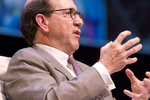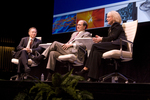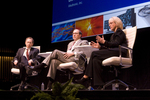- 2013 Research Triangle Park Summit
- 2013 Global Summit - London
- 2010 National Summit - Los Angeles
- 2010 Seattle Summit
- 2010 Chicago Summit
- 2010 Boston Summit
- 2010 Phoenix Summit
- 2010 Raleigh Summit
- 2009 National Summit - Durham
- Plenary Talk - Charles Vest
- Session I: Energy and the Environment
- Session II: Health
- Session III: Entrepreneurship
- Session IV: Security
- Session V: National Survey Findings
- Session VI: Understanding the Brain: Learning and Computation
- Session VII: Big Idea Panel
- Video/Essay Winners
- Speaker & Panelist Bios
- Poster Contest Winners
- Organizing Committee
- Summit Sponsors
- National Survey Results
- Grand Challenge Scholars Program
- Grand Challenge K12 Partners Program
Session II: Health
Robert Langer Keynote
Panel Discussion
Session Photos
Session Summary
Session moderator: Matthew O’Donnell, dean, University of Washington
Keynote speaker: Robert Langer, professor, MIT and recipient, 2008 Millennium Technology Prize
Panel discussion: Robert Langer; Bill Hawkins, CEO, Medtronic; Anna Barker, Deputy Director, National Cancer Institute
If the health and medicine keynote speech and panel discussion at the Grand Challenges Summit are any indication, major healthcare innovations will be coming down the pike in the coming years. “We’re at a point of convergence,” said panelist Anna Barker, deputy director of the National Cancer Institute. “We’ve got all these advances in molecular science converging with engineering, physical science and mathematics that will take us to 21st century medicine.”
Robert Langer, who gave the keynote address, is at the forefront of medical innovation. He and his colleagues are designing “smart” drugs and working on creating tissues and organs.
“One of the ways engineers have made tremendous progress has been in figuring out the right ways to deliver drugs to the body,” he said. Some years ago, Langer began working on the problem of using large molecules such as proteins, peptides, DNA or RNA as therapeutic drugs. Conventional wisdom said such large molecules could not be delivered as drugs because they are hard to swallow in pill form and have short lifetimes when injected. Langer challenged conventional wisdom, but did not have immediate success: “I found over 200 different ways to get this not to work.”
Finally he tried putting the molecules in microspheres made of polymers that could be suspended in solution. After injection, the macromolecules slowly move through pores in the polymer. “It takes a long time but the molecules get through. It’s like driving a car in Boston—there’s high tortuosity. By controlling the tortuosity, you can make release last anywhere from days to years.”
Microspheres like these are now used in the treatment of schizophrenia, prostate cancer, alcoholism and other diseases. In order to get microspheres and other innovations out into the market, Langer has been involved in starting up several companies. He has more than 600 patents, and patents of his have been licensed or sublicensed to more than 200 companies.
Langer is also exploring how to send drugs to specific places in the body. One strategy involves putting the therapeutic molecules in a nanoparticle. RNA molecules or other molecules act as guides to take the nanoparticles where they need to go (to a cancer cell for instance) and a polyethylene glycol coating prevents microphages from destroying the nanoparticles too quickly. This strategy is working well in studies with mice.
While watching a TV show about silicon computer chips, Langer got the idea to try using microchips to deliver drugs to a specific site. Drugs can be loaded in tiny wells on the chips and then released on demand using very small electric currents. “You can put these chips in animals for months and you can trigger release over and over again by radio telemetry,” he said.
Langer is also interested in making new materials. He noticed that a lot of medical materials, from dialysis tubing to breast implants, were co-opted from everyday objects at home, such as sausage casing and mattress stuffing. One of the first artificial hearts was made of polyester urethane, which is used to make ladies’ girdles. “Something that was designed to be a ladies girdle may not be the ideal blood-contacting material,” Langer said. “Being engineers we could take a different approach. What do you really want in a biomaterial? Then synthesize it.”
Taking his own advice, he designed a biodegradable polymer that can be placed in a surgical cavity after removing a malignant tumor. As the polymer degrades, it gradually releases chemotherapy right where it is needed rather than systemically. In a phase III trial using these polymers to treat a type of malignant brain tumor called glioblastoma multiforme, he said 31 percent of the people who had the treatment were alive after two years, compared to only 6 percent of the people in the control group.
Another challenge Langer’s lab is working on is growing human tissues. “Today, because of engineering, you can make tissues like skin,” he said. “It’s a huge challenge to make other kinds of tissue.”
His lab is experimenting with making cartilage to create new noses and ears, and has succeeded in animals. “We make a polymer scaffold for the cells; over time, the scaffold goes away,” he said. By then, cartilage cells have already assumed the shape of the scaffold.
All this engineering is intellectually stimulating in its own right, but for Langer, his work comes down to his overriding goals: “To relieve suffering and prolong life.”
The panel discussion after the talk focused on other innovations in health care including personalized medicine based on genetics. When an audience member asked a question related to his rare eye disease, which is correlated to a particular set of genes, Anna Barker said, “If everybody had their genome, then I think your kind of disease would be picked up easily and treated in childhood.”
The panel also emphasized the importance of informatics—the collection and analysis of health-related data, particularly genetic data. “We are generating terabytes of information every day in labs, universities, hospitals,” Barker said. “How do we connect research that goes on in the laboratory to what people actually receive? We have got to [develop] a way to capture information and aggregate it. It offers the most promise for progress in medicine.”
As an example, she mentioned Cancer Bioinformatics Grid, which aims to make genetic information about different cancer lines widely available to researchers and doctors online.
Bill Hawkins, CEO of Medtronic, Inc., agreed that bioinformatics is crucial part of the healthcare revolution. When asked by an engineering student what courses the student should take, he replied without hesitation, “Statistics.”
Summit TopicsSummit SpeakersSpeaker InterviewsSpeaker Topics





















































